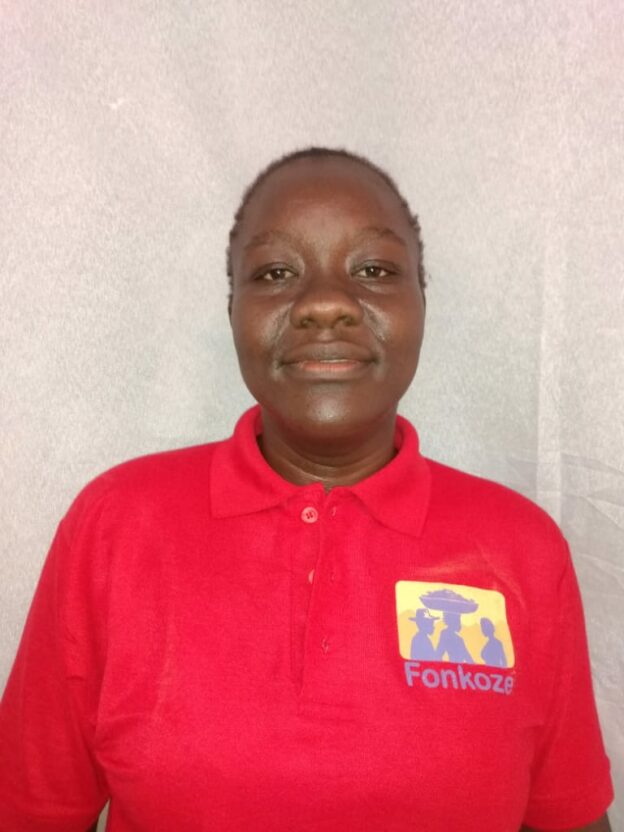By Samuel Gilbert, translated and edit by Steven Werlin
Marie Yslène Delarge lived in Lapwent, a neighborhood of urban Jeremi, though she moved to another, called Karakoli, while in the CLM program. Her journey through CLM was challenging, but she was finally able to change her life. She participated in the first group of inner-city CLM members and graduated from the program in February 2021.
Her family was not initially one of the 200 selected for the pilot of CLM adapted for urban settings, but another family chose to abandon the program, and Marie Yslène was able to replace them. She was living with a man who’d been sick for more than two months, their two girls, and her mother-in-law. At the time, things were so bad that she depended on a neighbor for the little bit of food she fed the family. The chance to join the CLM program became her one hope.
One of the first important questions her original case manager asked Marie Yslène was how much money she’d need to go into business. She said that she’d need 30,000 gourds to start one that could support her family. That was about $325 at the time. Her case manager talked to her about another woman who’d started a business with only 250 gourds selling chanmchanm, a Haitian snack made of corn ground together with sugar and peanuts. Marie Yslène decided to give it a try. She asked her neighbor to lend her 250 gourds, added 75 gourds of her own, and bought the ingredients she needed to make chanmchanm. She sold her chanmchanm in small bags, for five gourds each. She sold a large cupful for 150 gourds.
Within a week, she had 750 gourds. She decided to buy the flour and other ingredients she’d need to make ponkèt, a kind of muffin, and kokiyòl, which is like a donut. She had learned both baking and sewing, and could make the snacks well. She brought the 250 gourds back to her neighbor, but the woman told her it hadn’t been intended as a loan, but a gift, so Marie Yslène threw the extra money into her business, and was able to invest 1000 gourds.
She took a new step when she saw a woman pass in front of her home, selling charcoal. Marie Yslène bought her sack for 700 gourds. Unfortunately, the charcoal was wet, and it had been broken up so much in route that she couldn’t sell it all. She was only able to make back her investment. There was no profit. But she still had her chanmchanm, her ponkèt, and her kokiyòl, and she wasn’t ready to give up on charcoal.
Her first real setback occurred when she was still selling her different snacks. She made a batch of kokiyòl for 1750 gourds, and she gave it to a sister-in-law to sell for her. But the whole bag was ruined. The donuts were in the bag too long, and they became mushy and unsaleable. But she still had her main capital, so she was able to continue selling both the snacks she made and cooking charcoal. By this point, she was starting to feed her family with profits from her business.
The first cash she received from the program was a 4500-gourd deposit that was made into her Fonkoze savings account. She took 2000 gourds and made a payment to one of her children’s schools. The tuition bill was 8000, so 2000 was a good-sized payment. She used 800 gourds to buy four large bunches of sugarcane, which she was able to sell off as another snack in individual packets. She spent 1200 gourds on family expenses and left 500 in savings.
Each time Marie Yslène thought of taking a new step with her business, she would be sure to speak about it with her case manager. She wanted to be sure that she was making good decisions. She began saving money in a little lockbox, starting with 200 gourds. She also joined a sòl, a common sort of savings club in Haiti.
It was hard work, but she eventually had made enough profit to be able to invest in groceries, like rice, flour, oil, cornmeal, spaghetti, etc. She started that new business with 5000 gourds, and stopped selling her snacks. When the program finally was ready to transfer money for small commerce to her, she used the money to buy three sacks of charcoal along with fresh seasonings – like onions, parsley, and peppers – that sell well with standard groceries.
By early 2020, Marie Yslène felt that her business was still too small. She made a plan with her case manager to borrow 7500 for three months from her savings and loan association. She was the first CLM member to borrow money and pay it back. It was hard. With her commerce in her home, she couldn’t really walk around to make sales anymore, which had been a key to her initial success. And because her partner was no longer working, the entire responsibility for the family fell on her.
She hasn’t yet been able to realize one of her plans. As a tailor, and she’d like to buy a sewing machine. But rent payments made it hard to afford one. Even so, she was able to take 20,000 gourds out of her savings to pay for a wedding. She married the man she’d been living with.
She’s a different person now. Her children are in school, and they eat three meals a day. And she has plans. She wants to save her money so that, by the end of the year, she’ll have 100,000 gourds and be able to buy a small piece of land to build a house on. She wants to eliminate her need to pay rent.

Thanks, Steve. A very uplifting story from the first urban CLM program. Congratulations on getting all the detail from Samuel, who I assume was her case manager.